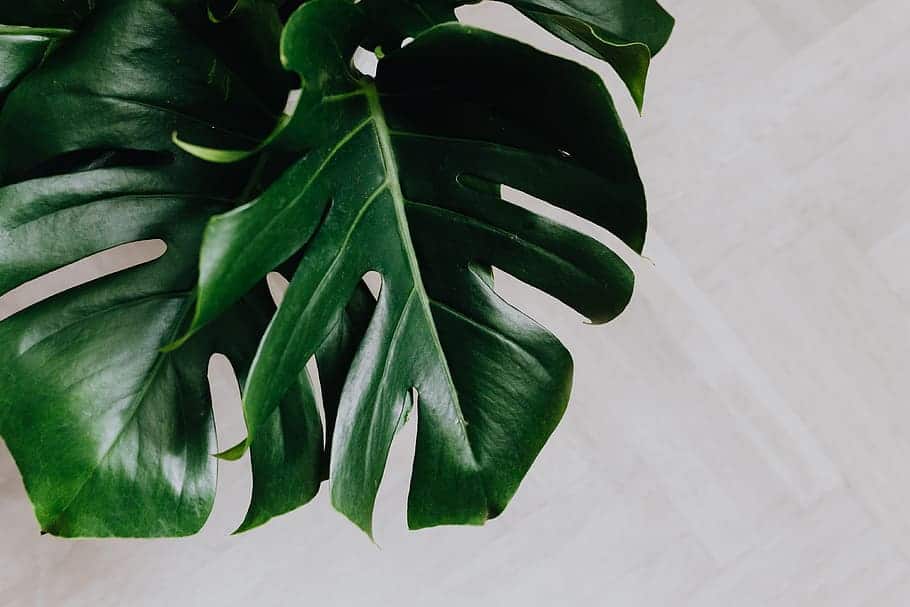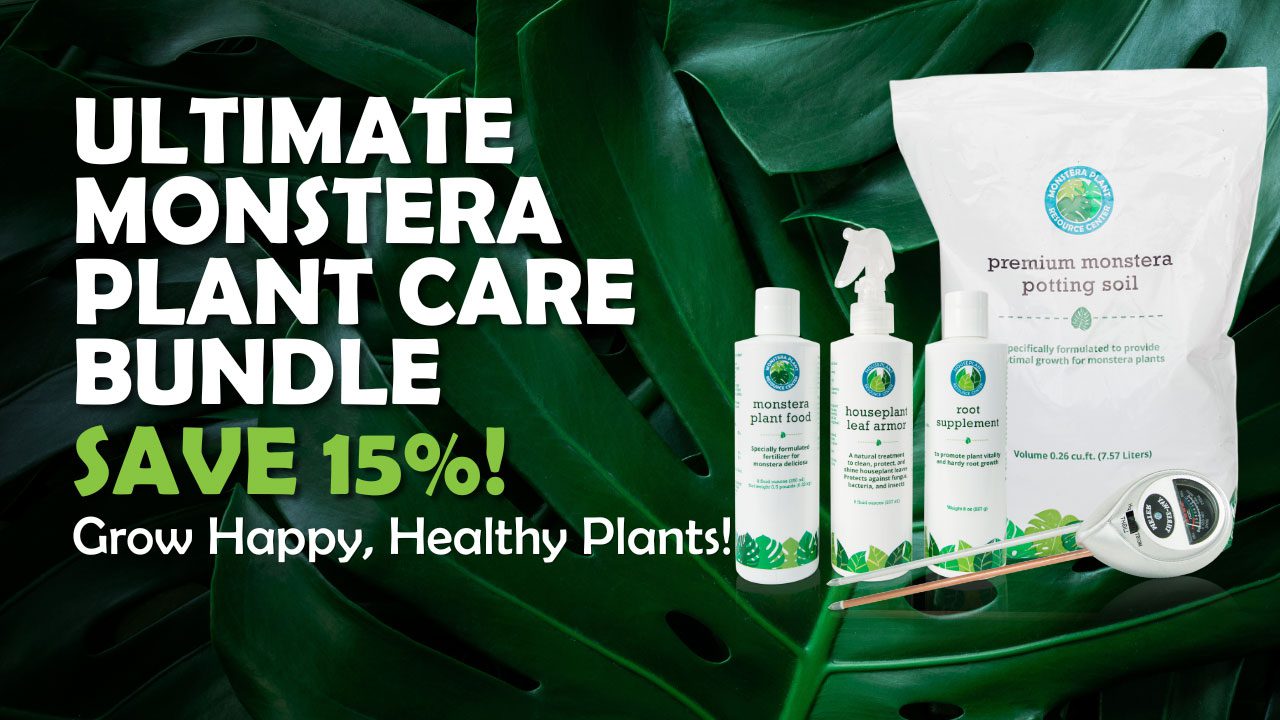The monstera is one of the trendiest plants out there right now. You’ve probably seen them everywhere, from Pinterest and Instagram to magazines and TV, even printed on clothing, notebooks, art, and lots more!
These plants are famous for their stunning, slotted leaves. (This splitting is called fenestration, by the way.) No one really knows why these plants grow these types of leaves, but one thing is certain: they’re beautiful, and one of the must-have houseplants these days.
Monstera deliciosa is the star of the show, which probably comes to mind when you hear “monstera.” This plant can grow up to 30 feet tall in the wild and up to 10 feet indoors. It produces massive fenestrated leaves and produces the Mexican breadfruit (hence the “deliciosa” part) though it rarely fruits inside.
There are many other species of monstera, including monstera dubia, monstera adansonii, and monstera siltepecana. They vary in appearance and availability, but they’re all gorgeous.
Learn more about those varieties here.
So how can you get a monstera, and then how do you take care of it once you’ve bought one? We’re here to help you out!
Table of Contents
Where to Buy a Monstera
Monsteras aren’t super common in stores like, say, snake plants, but you can find them with no problem if you know where to look.
Your local Home Depot or Lowe’s might carry them, but you’re more likely to find them at a local nursery or grower’s shop.
These plants are also fairly easy to propagate, so you might find houseplant fans in your area selling starter plants they’ve grown from their own monsteras! (If you’re interested in propagation, we recommend using our Propagation Promoter to help you propagate your monstera more quickly and with more success!)
You can also buy monsteras online from reputable sellers. EBay and Amazon are always options, as well as Etsy.
Here are a few of our favorite Etsy shops for purchasing plants:
Monstera Plant Care: What to Do Now
So you got your hands on a gorgeous monstera. Now what?
Here’s everything you need to grow a big, beautiful monstera plant in your home.
Light
Monsteras are rain forest plants, so they like bright but indirect sunlight. Choose a spot near a window where the light won’t beat right on it. As a rule, your monstera should never cast a shadow, because too much sunlight can burn the leaves. An east-facing window is usually best.
Choose the right pot and soil
Pick a fairly deep pot with a few drainage holes, or one big hole. Monsteras like peaty soil, so find a nice, peaty mix or just add a little extra peat moss to indoor potting mix.
Give them something to climb
Monsteras are actually climbing plants, so give them a trellis or moss pole for their aerial roots to grip as they grow up. They can still grow without a pole or trellis, but they’ll grow “out” instead of up and take over your room in no time!
Read our tutorial on making a moss pole for your monstera here.
Water
This is where most plant owners get it wrong by either drowning their plants or drying them out.
Monsteras are native to the tropical rain forests of Central America, so they like a fair amount of water. Water when the top 1-2 inches of soil feels dry to the touch. To water, slowly add water to the soil until it just starts to drain out the bottom. Empty the drainage tray right away or better yet, stick the whole plant in the sink so it can drain for a while.
Read our guide on watering your monstera here.
Use the Right Fertilizer
Plants get their energy from the sun, but they need nutrients from the soil. Plants can use up all the nutrients in their potting soil in a matter of months, so it’s important to give them the right fertilizer that provides nutrients to support healthy growth, shiny leaves, and prevents disease.
Monsteras grow mostly during the spring and summer, so I add a little Indoor Plant Food to my soil when I water my monsteras each week. They love it!
Indoor Plant Food is also great for just about any indoor plant, so you can just add it to your watering can when you make your watering rounds!
Other Things to Watch Out For:
Humidity
Monsteras are tropical plants, so they need humidity to be healthy. If your leaves start to pucker or dry out (and you aren’t under-watering) try adding a humidifier nearby or setting up a pebble tray for your plant.
Root Rot
Monsteras like water, but they don’t like sitting in it for too long. If you notice dark brown spots on your monstera’s leaves, especially near the bottom of your plant, you might have a root rot problem.
Read about treating root rot here.
Monsteras are toxic
Monsteras are toxic to humans and animals when ingested, so keep these out of reach of children and pets.
Clean Your Leaves
Plants use their leaves to carry out photosynthesis and respirate, so keep them free of dust so you don’t starve or suffocate your plant. Once a week or so, use a soft cloth to gently dust your monstera’s leaves. We also recommend our Houseplant Leaf Shine, which not only cleans and adds shine to your plant’s leaves, but also protects against bacteria, fungus, and insects.
Pruning
Monsteras can grow up to 10 feet indoors, so your plant might need occasional pruning to keep it from taking over your house!
When it’s pruning time, put on some gloves and use a sharp, clean tool to cut your plant down to size. If you want, you can even propagate the leaves to make even more monsteras! (To propagate your monstera more quickly and with more success, we recommend using our Propagation Promoter!)
Insects
All houseplants can attract pests, and monsteras are no different. Here’s a guide to common household pets that might bug your monstera and how to get rid of them. Also try our Houseplant Leaf Armor to protect your plant from bacteria and fungus as well as insects.
You’ll Be a Pro in No Time!
Monstera care might seem intimidating at first, but it’s actually pretty simple once you get in a groove with it.
For more tips on growing monsteras in your home, check out our monstera care Facebook group!
To learn more:
- Sign up for our free Ultimate Monstera Webinar.
- Subscribe to our newsletter.
- Click to join our community on Facebook: Monstera Plant Resource Group.
- Read our Ultimate Monstera Watering Guide here.
- Be sure to grab your essentials here: Houseplant Propagation Promoter, Monstera Plant Food, 3-in-1 Moisture Meter, Premium Potting Soil, Houseplant Leaf Armor (which protects your houseplant from bacteria, fungus, and insects—and also cleans and adds shine to its leaves!)





